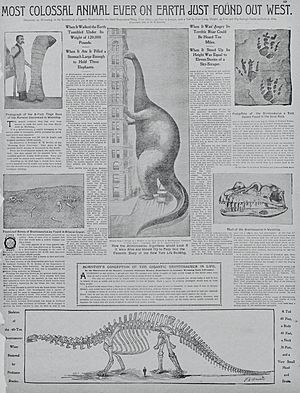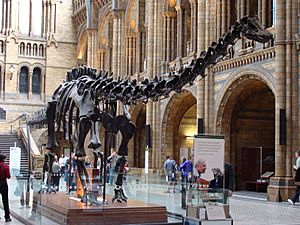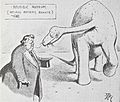Dippy facts for kids
| Catalog number | CM 84 |
|---|---|
| Common name | Dippy |
| Species | Diplodocus carnegii |
| Age | 145–156 Ma |
| Place discovered | Sheep Creek Quarry D, near Medicine Bow, Wyoming; upper 10 m (33 ft) of the Talking Rock facies of the Brushy Basin Member of the Morrison Formation |
| Date discovered | July 4, 1899 |
| Discovered by | William Harlow Reed |
Dippy is a very famous Diplodocus dinosaur skeleton. You can see it at the Carnegie Museum of Natural History in Pittsburgh, USA. It's special because it's the main example of the Diplodocus carnegii species. Many people think it's the most famous dinosaur skeleton in the world.
This is because rich businessman Andrew Carnegie had many copies of Dippy made. He gave these copies, called plaster casts, to big museums all over the world in the early 1900s. These copies helped make the word "dinosaur" well-known. For many people, Dippy was the first dinosaur they ever saw! It also made the Diplodocus dinosaur very popular.
Dippy's story began when a large thigh bone was found in Wyoming in 1898. Andrew Carnegie heard about it and paid for more digging. On July 4, 1899, a toe bone from Dippy was found. Because it was found on Independence Day, and because its copies were used to help countries get along, it was nicknamed the "star-spangled dinosaur." Dippy became the main attraction at the Carnegie Museum, so much so that people called the museum "the house that Dippy built."
Contents
How Dippy Was Found
Dippy's bones were found in Albany County, Wyoming. They were in a rock layer called the Morrison Formation.
In 1900, John Bell Hatcher became the expert in charge of dinosaurs at the Carnegie Museum. He oversaw the digging up of Dippy's bones. He also studied them and helped put them on display. Hatcher named the new species Diplodocus carnegii after Andrew Carnegie. He wrote a detailed book about Dippy in 1901.
Dippy is a "composite skeleton." This means it's made up of bones from different Diplodocus dinosaurs.
- Most of the skeleton (called CM 84) is the original Diplodocus carnegii.
- Some missing bones were filled in with bones from other Diplodocus finds.
- The tail (CM 307) came from another find.
- Some skull parts (CM 662 and USNM 2673) were used. However, scientists later realized these skulls might belong to a different dinosaur called Galeamopus. This means we don't have a definite Diplodocus skull known today.
- A few foot and leg bones from a Camarasaurus were also used.
Dippy in Pittsburgh
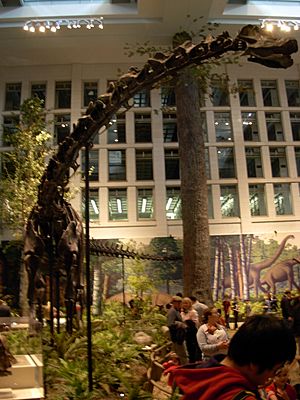
The original Dippy skeleton has been on display at the Carnegie Museum of Natural History since April 1907. It took two years after the first copy was made to put the original on display. This was because the Pittsburgh museum needed to build more space to fit Dippy. Today, you can see Dippy in the museum's Dinosaurs in Their Time exhibit.
Dippy's Famous Copies
Why Copies Were Made
Andrew Carnegie paid for Dippy's discovery and for all the copies. His great-grandson, William Thomson, explained why these copies were given away. Carnegie wanted to show that countries have more in common than what separates them. He hoped that sharing scientific discoveries would help countries talk to each other and work for world peace. It was a kind of "Dinosaur diplomacy."
The London Copy
The idea for a London copy of Dippy came from King Edward VII. He saw a drawing of the bones at Carnegie's home in Scotland in 1902. Carnegie agreed to give a copy to the Natural History Museum as a gift. Carnegie paid £2,000 to have the copy made from plaster of paris. This was done by copying the original fossil bones in Pittsburgh.
The London copy had 292 pieces. They were sent to London in 36 big crates. The 21.3 metres (70 ft) long dinosaur was shown to the public on May 12, 1905. Many people and news reporters were very interested. Important people like the museum director and Andrew Carnegie himself gave speeches. The copy was first put in the museum's Reptile Gallery. It was too big for the Fossil Reptile Gallery.
During the Second World War, Dippy was taken apart and stored in the museum's basement. This was to protect it from bombs. After the war, it was put back together. Over the years, how Dippy was displayed changed. This was to show new scientific ideas about how the dinosaur stood. For example, its head and neck were first pointed down. Later, they were moved to a more horizontal position.
In 1979, Dippy was moved to the main central hall of the museum. This hall was later renamed the Hintze Hall. Dippy took the place of a large African elephant skeleton. The elephant had been the main exhibit there since 1907. Before that, a sperm whale skeleton was on display. Dippy was also shown with a copy of a Triceratops skeleton for a while. The tail of the Diplodocus copy was also lifted up. It used to hang down to the floor.
The London Dippy became a symbol of the museum. After 112 years on display, the dinosaur copy was removed in early 2017. It was replaced by a 25 m (82 ft) long skeleton of a young blue whale, nicknamed "Hope." A BBC TV show called Horizon: Dippy and the Whale showed how this big change happened.
Dippy then started a tour of museums across the United Kingdom in February 2018. It was put on a new, easier-to-move frame. Dippy has visited many places, including the Dorset County Museum, Birmingham Museum and Art Gallery, Ulster Museum, Kelvingrove Art Gallery and Museum, and Norwich Cathedral.
Other Copies Around the World
William Holland, who was the director of the Carnegie Museums, helped send these copies around the world. He even wrote a book about his trip to Argentina in 1912. A popular poem among college students at the time showed how famous Dippy was:
Crowned heads of Europe
All make a royal fuss
Over Uncle Andy
And his old diplodocus.
Many other copies of Dippy were made and sent to museums. These include:
- Berlin, Germany (1908) at the Museum für Naturkunde
- Paris, France (1908) at the French National Museum of Natural History
- Vienna, Austria (1909) at the Natural History Museum
- Bologna, Italy (1909) at the Giovanni Capellini Museum for Paleontology and Geology
- St. Petersburg, Russia (1910) at the Zoological Museum of the Russian Academy of Sciences (later moved to the Moscow Paleontological Museum)
- La Plata, Argentina (1912) at the Museo de la Plata
- Madrid, Spain (1913) at the National Natural History Museum
- Munich, Germany (1932) at the Paleontological Museum (this one was donated but never put together)
- Vernal, Utah, USA (1989) at the Utah Field House of Natural History State Park Museum (this copy is made of fiberglass and polyester)
The Pittsburgh Statue
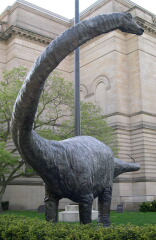
In 1999, a large statue of Dippy was put up outside the Carnegie Institute and Library complex in Pittsburgh, Pennsylvania. This was to celebrate 100 years since Dippy was first found. This dark, grayish-brown statue is made of fiberglass. It weighs 3,000 pounds (about 1,360 kg), stands 22 feet (about 6.7 meters) tall, and is 84 feet (about 25.6 meters) long. It was made over nine months, based on the original fossil.
The statue stands near Forbes Avenue, close to the Carnegie Music Hall and the Carnegie Museum of Natural History. Dippy is a fun mascot for the museum. Sometimes, it wears a giant scarf when it's cold. It has also been seen wearing the Terrible Towel of the Pittsburgh Steelers football team. Dippy is a well-known landmark in Pittsburgh.
Gallery
-
The New York Times news about the London copy in 1905.
-
An image of Dippy from H. G. Wells's 1922 book A Short History of the World.
See also
 In Spanish: Dippy para niños
In Spanish: Dippy para niños


